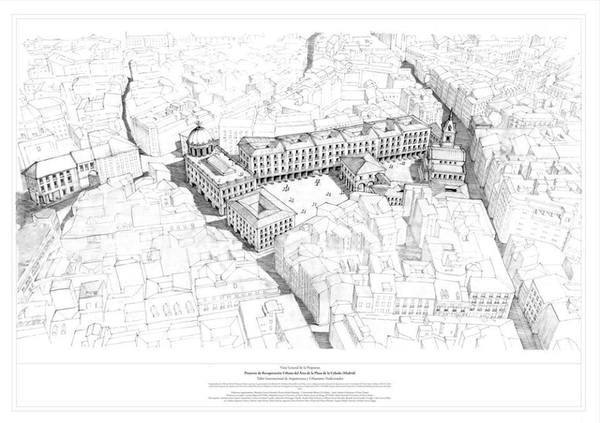June 2014
 Aerial perspective of the counter-project.
Aerial perspective of the counter-project.
For centuries, Plaza de la Cebada in Madrid, Spain, stood as an open market dedicated to the sale of barley and other cereal grains. In the nineteenth century a cast iron market structure occupied part of the plaza, and this structure was replaced in the nineteen sixties with a market consisting of six halls each of which being surmounted by shallow concrete domes. The municipality of Madrid has recently decided to raze the concrete halls to the ground and to commission a proposal to replace them with a massive shopping mall that violently ignores the architectural character and the scale of blocks and buildings of Madrid’s Latina quarter.
 One of the two new Plazas.
One of the two new Plazas.
In order to draw attention to the need for any new proposal to reintegrate squares, blocks, and streets to the Latina quarter, Professor Samir Younés (University of Notre Dame) and Professor Alejandro Garcia Hermida (Universidad Alfonso X, Madrid) co-directed a five-day counter-project for Plaza de la Cebada. Based on a conceptual sketch provided by Professor Samir Younés, the counter-project was developed with teaching assistants, Alejandra Gutzeit, and Mark Santrach from U.N.D., and Carmen Bueno and Javier de Mingo from the Politecnico de Madrid. The participants from Spanish universities were: Helena Garcia Hermida, Alejandro Dominguez, Andrea Figueroa, Amalia Maria Dumitru, Antonio Cañero, Maria Lopez Porras, Maria Moreno Aguaron, Virginia Ripoll, Ricardo Jose Gonzalez Granger, Celia García Albertos, Carlos Corchado, Estibaliz Sierra, Rosa Mouriño. This initiative was supported by the Richard H. Driehaus Charitable Lead Trust , The Universidad Politecnica de Madrid, and the University of Notre Dame’s School of Architecture.
 The proposal and its integration with the Latina quarter and the church of S. Andrés.
The proposal and its integration with the Latina quarter and the church of S. Andrés.
As the Plaza de la Cebada exceeds in length the city’s Plaza Mayor, the counter-project provides for two plazas contained with mixed-used buildings where all ground floors are dedicated to commercial purposes and where the upper floors can be dedicated largely to apartments. The proposal also accommodates a gallery, a bank, a department store as well as below-grade parking and connections to the metro service. In order to illustrate the importance of the local architectural character and tectonic details, some of the participants also produced a lexicon of local construction methods.
To view additional images, please visit the School of Architecture on Flickr.